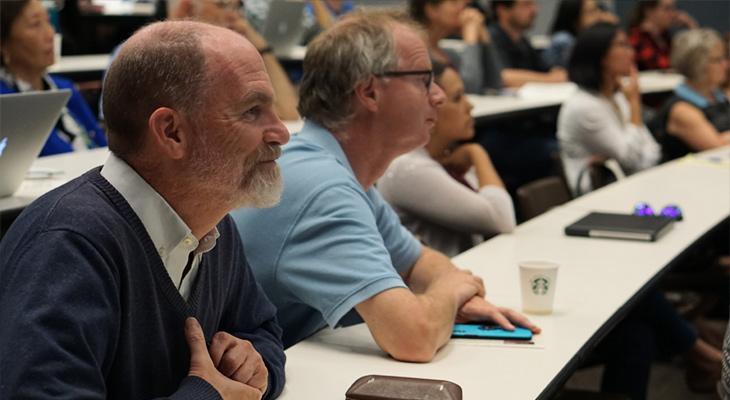bi·o·sta·tis·tics
bīōstəˈtistiks/noun
Making sense of all the data. That’s one way of defining what a biostatistician does.
Or, as Professor and former Department Chair Patrick Heagerty likes to put it, “Turning data into knowledge.”
Biostatisticians use statistical methods and techniques to improve the health of people and communities. They help answer pressing research questions in medicine, biology and public health, such as whether a new drug works, what causes cancer and other diseases, and how long a person with a certain illness is likely to survive.

“What, for example, does the data say about the association between an environmental exposure and a health outcome?” asks Heagerty, whose expertise is longitudinal studies, or data collected over time.
“Biostatistics is central to all of science, because science needs that gathering of evidence and the evaluation of that evidence to make a judgment.”
Biostatisticians use their quantitative skills to team with experts in other fields, from biologists and cancer specialists to surgeons and geneticists. But they are not mere number-crunchers. They play pivotal roles in designing studies to ensure enough data and the right kind of information are collected. Then they analyze, evaluate and interpret the results – accounting for variables, biases and missing data along the way.
“It’s a field that merges passion and skill with biomedical science and mathematics and statistics,” Heagerty says. “It’s got to have the bio in it somewhere.”
Adds Associate Professor Daniela Witten, “What we bring to the table is an understanding of not only the key statistical issues, but also the underlying biological and medical context.”
Some examples of ongoing and recent biostatistics work at the UW and its potential impact:
- Professor and former Department Chair Thomas Fleming was senior author of a study that showed antiretroviral therapy reduced the risk of heterosexual transmission of HIV by 96 percent – a discovery that could save countless lives and illnesses. Science magazine dubbed it the 2011 “Breakthrough of the Year.”
- Heagerty’s work on back pain with other UW colleagues showed that epidural injections for a common type of back pain made virtually no difference for patients – a finding that could potentially save costs and unnecessary medical procedures.
- Finding links between genetic variants and certain diseases. Now that genome sequencing is relatively cheap, scientists “should be able to identify the genetic underpinnings of a lot of human diseases and obtain a much better understanding of the science than was ever possible before,” according to Witten. That’s what precision medicine and targeted therapy is all about.
- Working with UW Biology Professor Samuel Wasser to use DNA from elephant tusks and dung to pinpoint where poaching occurs in Africa, giving law enforcement and conservation authorities the tools they need to crack down on the illegal trade.
At the UW, the Department of Biostatistics does two main things, according to Heagerty. It prepares students to practice biostatistics on a wide range of scientific teams and it develops ground-breaking thinkers through its PhD program.
“We’re training the next generation of innovators in the methodology,” he says.
That’s important in an era of emerging data sets, from genome sequencing to electronic medical records. New statistical tools and software are often needed to interpret the massive amounts of data and to detect correlations and causations.
The department has a long history of developing innovative methodology.
One of the classic investigative techniques in epidemiology is the case control study. This is research that starts with the outcome, or disease, first, then goes back to find risk factors that could have caused the disease. “It’s sort of a backward study design,” Heagerty says. “But it’s a really efficient study design. Those ideas were developed here by Ross Prentice (professor of Biostatistics).”
Professor Emeritus Norm Breslow, a former Chair of the department, was a leader in the development of survival methods used to study the time until an event such as death occurs. “These are huge contributions to medicine,” Heagerty says.
Then there are clinical trials, where researchers study the impact of a drug versus a placebo.
“Our department became prominent because of its work on how clinical trials are conducted and how the results are interpreted,” says Professor and former Chair Bruce Weir, a pioneer of statistical genetics. “Tom Fleming, Scott Emerson, Norm Breslow and Patrick Heagerty have developed new statistical methods to design clinical trials to interpret the results.”
UW biostatisticians also use their expertise to serve on data safety monitoring committees, overseeing numerous trials to see if they should be stopped early to prevent harm to participants or because a therapy or drug proves immediately effective.
The job market for biostatisticians is hot, from high-tech and pharmaceutical companies to research institutions. Some of the UW’s graduates have gone on to head academic departments elsewhere, giving the department a major role in shaping the careers and educations of biostatisticians across the country.
“The demand for people with our training is enormous,” Heagerty says. “This is a data-rich world and people who can gather the evidence and evaluate it are incredibly valuable in every domain – research, business or health care systems.”